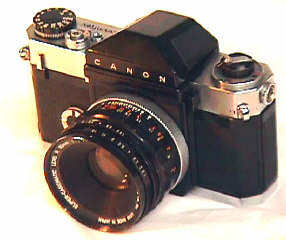
Home
Camera
Articles FOR SALE
Orders
I Buy / Wants Repairs
Books Adapters 
Canon's 1st SLR the 1959 Canonflex
"with Automatic Springback Diaphragm and Mirror" from 1959 Canon Brochure Springback??
Nice camera, but blown away by the Nikon F
Both introduced in March of 1959, the original Canonflex was discontinued in five months after about 17,000 were made. The Nikon F continued until 1974 with a production of about 862,000!!
The Canonflex was, and is, a nice camera. These days more collectors are starting to appreciate this large well made beast. Yet for its day in June of 1959, the Canonflex simply could not compete with the soon to be legendary Nikon F in terms of features, system, or sales. Not to worry though. Canon eventually got its revenge 30 years later when the EOS Autofocus lineup blew away the best AF Nikon could offer at the time, the Rover 2020, aka the Nikon 2020.
Probably the first impression you will get picking up a Canonflex is appreciation for its large size and nice finish. It is a well made camera. The second thing you will probably notice is its odd bottom lever film advance. This was a big Canon selling point, claiming that the 130 degree bottom lever advance was faster than the top mounted lever. Up to 3 frames per second were claimed possible.
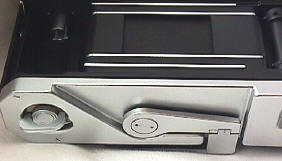
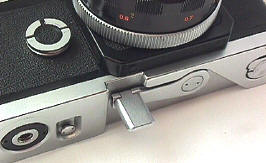
Unfortunately for Canon, most photogs did not find the bottom lever advance convenient on a tripod. Others like myself merely found it odd. Though of course, some people loved it. Rumor is that the Canonflex was very popular with Edsel owners. Rewind button and back opening key are located on the bottom plate. Double exposures were very easy. Just take the first shot, push in the rewind button, advance and take the second shot!
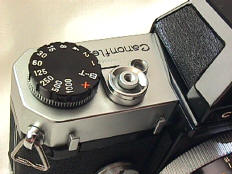
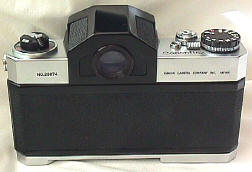
The overall layout of the camera is very clean. Note the extremely large, easy to grasp shutter speed dial. If there is a larger shutter speed dial on any 35mm camera, I would like to know about it. Shutter speeds are a conventional 1 to 1/1000. A nice touch is the shutter lock located around the shutter release. Strangely however, the shutter works AFTER the exposure, stopping more shots being taken, rather than BEFORE the exposure. Try to figure that one out.
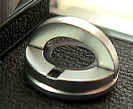
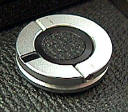
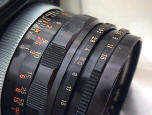
That round thing is the self timer. Look closely at the lens. Although it had an automatic diaphragm which stopped down and opened up again after the exposure, depth of field was not so easy. You had to manually stop down the lens with the 2nd f/stop ring, and then manually open it up again.
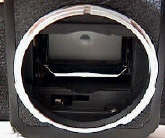
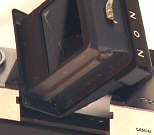
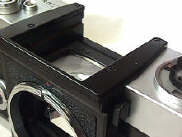
The Canonflex introduced what was to become the famous Canon breech lock mount. The selling point is you always have a secure mount, since any wear is automatically compensated for by tightening the breech. Real world, this system took noticeably longer to attach or remove lenses. Worse, the extended pins and levers were unprotected without a rear lens cap. Despite what eventually was to be almost 30 years of singing its praise, Canon eventually replaced their breech mount with a conventional bayonet mount on the EOS.
The Canonflex MOUNT is almost the same as the later Canon FL/FD series cameras, but NOT the same. Lenses have a different set of connections at the back. In practical terms, you may damage your camera or lens by interchanging earlier Canonflex bodies and lenses with later FL/FD bodies and lenses. Some will be OK, some not OK, so be careful.
The removable pentaprism was very nicely done, riding on backward sliding rails like the Miranda Orion. This mounting system is one of the few areas that Canonflex excelled the Nikon F. A waist level finder and a 4x magnifier were also available. Focusing screens were not interchangeable.
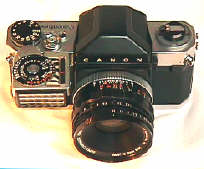
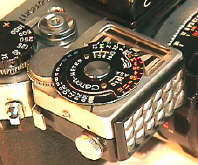
Today the removable exposure meter is rather hard to find. It clipped on with a spring loaded clip, the button of which is visible near the camera strap lug. Both high and low ranges were possible, coupling to the shutter speed dial. You then read the f/stop reading and transferred it to the lens.
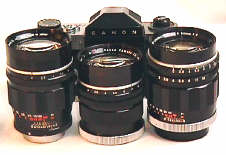
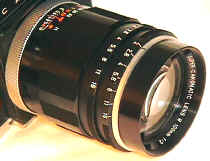
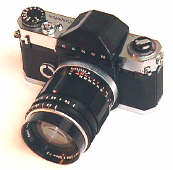
When introduced, there were only two Canonflex lenses with automatic diaphragms, the 50/1.8 and the 100/2. Notice three 100/2's on the left.
On the far left is the famous 100/2 Canon lens in Leica screw mount, made for the Canon 7 and 7s. On the right is the 100/2 Canonmatic lens. In the middle?? That is the 100/2 Leica mount lens head mounted in the Canonflex focusing adapter RA. This allowed some Canon rangefinder lenses to be used on the Canonflex. The RA could be used with the 85/1.9, 100/2, and 135/3.5 Canon rangefinder lenses. The RB adapter was for the 100/3.5.
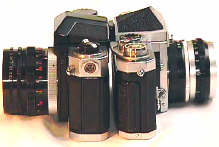
Today most photogs consider the Nikon F a large SLR. Yet, as you can see, the Canonflex was actually slightly larger.
Canonflex Lens Lineup
Eventually Canonflex would be expanded to include a 35/2.5, 50/1.8, 50/1.2, 85/1.8, 100/2, 135/2.5 R lenses with automatic diaphragms. There were also the 100/3.5 and200/3.5 R with pre-set diaphragms. Longer lenses made in R mount were the 300/4, 400/4.5, 600/5.6, 800/8 and 1000/11. Two of the most difficult to find lenses are the 55-135/3.5 Zoom and the 50/1.2.
Initially the Canonflex lineup was primarily Canon Rangefinder. ALL Canon Rangefinder lenses 85mm and longer were usable on the Canonflex!! The Focusing Adapter R allowed use of 85mm, 100mm, and 135mm Canon Rangefinder lens heads on the Canonflex---of course with totally manual diaphragms. The Tele-Coupler R was used with the 200 and longer Canon Rangefinder lenses on the Canonflex -- taking the place of the Canon Reflex housing.
Canonflex Failures
Paradoxically, the Canonflex was a strange mixture of advanced design and backward design.
While the bottom mounted lever advance could be easier and faster than a conventionally mounted top mounted lever advance, it made other camera operations MORE difficult. With one hand on the lever advance and the other on the shutter release, photographers had no third hand to follow focus moving subjects. Overall, this made the conventional layout faster in practice. As a result, most photogs preferred top lever advance to bottom lever advance
The exterior Canonflex was very clean and futuristic, yet important features were lacking. Importantly, it has a very useful shutter release lock, a very large and easy to use shutter speed dial, and a wonderfully engineered finder removal system. Yet, the Canonflex strangely lacks interchangeable focusing screens and a mirror lockup. Critically lacking was the convenience of ALL automatic diaphragm lenses.
Limited initial lens lineup. The Canonflex was introduced with only TWO automatic diaphragm lenses, the 50/1.8 and 100/2. All other introduction lenses were adapted from the Canon rangefinder lineup with inconvenient for SLR manual diaphragms: the 85/1.9 (a rangefinder lens head on a Canonflex adapter), 100/3.5, 135/3.5, 200/3.5(a rangefinder lens head used with the Tele-Coupler R), 600/5.6, 800/8, and 1000/11. In contrast, the Nikon F was introduced with lenses from 21 to 500.
The Canonflex was introduced with NO WIDE-ANGLE LENSES. That's right folks, unbelievable, but true. Not surprisingly, this is a mistake not repeated 30 years later with the EOS.
Nikon F features the Canonflex did not Equal
The F had a use in the field professional electric motor drive (a SLR first)
The F had a 250 exposure back (a first for Japanese SLR's)
The F had interchangeable focusing screens (a first for Japanese SLRs)
The F had 100% viewfinder
The F had an easy to use depth of field button (a first for Japanese SLRs)
The F had a mirror lock up (a first for Japanese SLRs)
The F had lenses ranging from 21 to 1000mm (a first for Japanese SLRs)
Other Canonflex Models
Canonflex R 2000, 1960, similar to Canonflex but with a top speed of 1/2000th. It is the rarest Canonflex with a production of about 8,800. They are very hard to find. The Konica F was the first 35 SLR with a top speed of 1/2000th, introduced a few months before the R 2000.
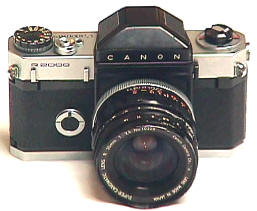
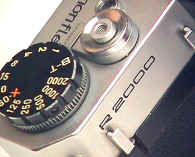
Canonflex RP, 1960, similar to Canonflex but fixed pentaprism, production about 31,000
Canonflex RM, 1962, Similar to RP but built in selenium meter. The most common Canonflex with about 72,000 production.
The Canonflex line was replaced with the familiar modern Canon FL/FD mount in 1964, starting with the relatively hard to find Canon FX with external CDS meter. When introduced, Canon was distributed in the US by Scopus Inc. Later in the 1960's Canon was distributed in the US by Bell & Howell. Eventually Canon did its own US distribution and achieved much higher sales.
Canonflex Collecting Tips
Canonflex lens cases were very well done in brown leather. They are all prominently embossed on top -- such as "Canon R 35/2.5." Cases will turn up without lenses, but you need to know what to look for.
Most of the original Canonflex lens caps -- maybe all? -- used black plastic lens caps labeled "Canon."
Original Canonflex rear lens caps are black plastic. The edges are plain. The back of the cap has a 4mm wide plain lip on it, inside of which is a light textured plastic which reminds me of crinkled paint. They are labeled "Canon" below the center of the cap, below which is "Japan" in smaller letters. The capital "C" is rather large, 5mm high.
There are at least two different clip on meters. The one for the R2000 has a top speed of 1/2000th. The other models use the meter with a top speed of 1/1000th.
I my experience at least, I have found Canonflex bodies to be relatively dependable and sturdy. I can not say the same of Canonflex lenses, which seem to have more than their share of mechanical problems. Of course the number one problem (like so many other early SLR's) is a sticking diaphragm. The other problems are various mechanical problems such as aperture linkage and bent connecting levers at the back of the lens. So, when you are buying one, be sure to inspect the lenses carefully.
Home Camera Articles FOR SALE Orders I Buy / Wants Repairs Books Adapters
Revised: November 25, 2003 . Copyright � 1998-2002 Stephen Gandy. All rights reserved. This means you may NOT copy and re-use the text or the pictures in ANY other internet or printed publication of ANY kind. Information in this document is subject to change without notice. Other products and companies referred to herein are trademarks or registered trademarks of their respective companies or mark holders.